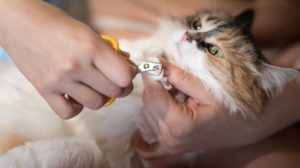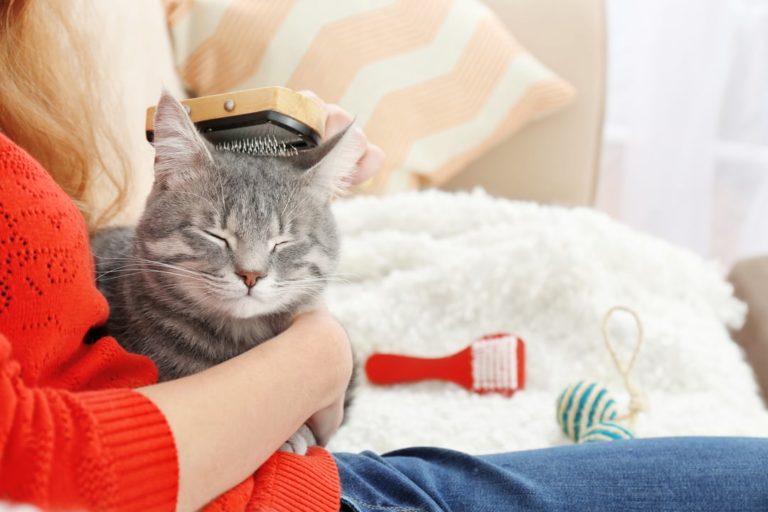Cats are famous for their cleanliness. Spend some time watching your cat, and it won’t be long before you see her grooming herself fastidiously, rarely missing a spot. But does that mean she doesn’t need your help staying clean? Absolutely not! Cats needs human help with their grooming needs, and there’s plenty of reasons why.
Reasons to Groom
Although your cat does a good job at keeping herself tidy, you can do a lot to contribute to both her cleanliness and her good health. Here are some important reasons you should regularly groom your cat:
Looking good
If you think your cat is pretty attractive, she’ll look even better if you give her a good grooming yourself. While her scratchy tongue does a lot to remove dirt and other substances that stick to her coat, a good quality grooming brush can make her even cleaner. A brush will remove whatever dirt and dust remains on your cat’s fur, particularly in places your cat finds difficult to reach.
Besides removing dirt and debris from your kitty’s coat, regular brushing will also help bring out the natural oils in her skin. These oils will keep her hair looking shiny and healthy, and also discourage drying and flakiness of her skin.
Help with hairballs
All cat owners are familiar with hairballs, those disgusting wads of hair your cat vomits up on the floor. Hairballs form when your cat ingests large amounts of fur while grooming herself. The tiny hook-like structures on her tongue are good at pulling out loose hair, which is then swallowed.
Some of the hair passes through the intestines and is deposited in the litter box, along with your cat’s poop. Other times, the hair wads together and sits in your cat’s stomach, where it causes irritation. Your cat eventually throws up these wads in a tube-like shape after they have passed through the esophagus on the way out.
Even worse for your cat than vomiting up the wadded up hair is trying to pass it. Your cat’s digestive system may try to move the fur ball from her stomach into the intestines, instead of up through the esophagus. If the hair gets stuck here, it can cause a blockage. An intestinal blockage can be life threatening and requires immediate intervention from a veterinarian.
By brushing your cat weekly—or even daily in the spring and fall when shedding is at its highest—you can help keep hairballs to a minimum. If you are brushing away loose hair, less of it will end up on your cat’s tongue and inside her stomach.
Cleaner furniture
You have no doubt noticed that your cat leaves hair on your furniture—and likely your clothes and your rugs, too. This happens when loose hair falls off your cat’s body and clings to soft surfaces. You can try getting it off with a heavy-duty lint roller after the fact, but a better idea is to regularly brush your cat so that loose hair gets caught up in your brush instead of on your belongings.
Daily brushing is most effective for minimizing the amount of cat hair deposited on furniture and flooring. The more hair you can remove yourself, the less there will be to scatter around the house.
Trimming nails
Another important aspect of grooming your cat is trimming her nails. Cats’ nails grow continuously, just  like human fingernails do, and if you don’t trim them, they will become longer and sharper over time. The won’t grow past a certain point since they simply shed out the top layer the old nail and replace it with a new one, but your cat will still have some pretty crazy talons if you don’t intercede.
like human fingernails do, and if you don’t trim them, they will become longer and sharper over time. The won’t grow past a certain point since they simply shed out the top layer the old nail and replace it with a new one, but your cat will still have some pretty crazy talons if you don’t intercede.
You can eliminate a number of problems by trimming your cat’s nails on a regular basis, at least once a month. By doing so, you will minimize the damage on your furniture and carpeting. Hopefully your cat has learned to use a scratching post to work out her nails, but in the event that she’s inclined to use the couch or your new rug, the destruction will be less if the sharp tips of her nails have been trimmed.
Another reason to keep your cat’s nails trimmed is for your own safety. Have you ever been accidentally scratched by your cat when she is playing with you, leaping off your lap or resisting medication you need to give her? The damage in these situations is a lot less if your cat’s nails are trimmed, and the sharp points have been removed.
And finally, a good reason to trim your cat’s nails is to keep her from getting stuck on things. Window screens, scratching posts, throw rugs and your clothing are all items that can easily snag a sharp feline claw, leaving its owner helpless to remove her paw. If you keep the sharp tips clipped off your cat’s nails, you’ll prevent “claw catching” from happening.
Physical exam
If you are like most cat owners, you spend quality time petting your cat. When caressing your kitty, you are likely to accidentally discover any unusual wounds, lumps or bumps that might be present.
Rather than randomly coming across problems that might exist on your cat’s body, you can also use grooming sessions to deliberately look for anything abnormal on your cat. Skin irritations, lumps, cuts and even ticks and fleas are most easily discovered when you are focusing on grooming your cat and keeping an eye out for problems rather than absentmindedly stroking her fur.
As part of your grooming sessions, take a look into your cat’s eyes and look for any irritation or discharge. Peek inside her ears too and make sure they look clean. Note any dark discharge deep inside the ear as this may signal a problem like ear mites or a bacterial infection. Before or after you trim her nails, examine her paw pads to make sure they are free from cuts or abrasions. (If your kitty goes outdoors, keep a look out for trapped burrs and foxtails too.) Give your cat’s entire body a once-over with your hands to feel for any lumps, and be sure to conduct a visual inspection of the skin around her neck and on her belly to look for any skin irritation.
If you uncover something on your cat’s body that shouldn’t be there, contact your veterinarian and veterinary team for advice. The problem may be small, or could indicate a more serious condition.
Bonding
If you ask any Cat Trainer, one of the greatest rewards of regular grooming sessions with your cat is deep bonding. The time you spend with your cat as you brush her coat, trim her nails and examine her body will go a long way toward fostering the relationship between the two of you. Most cats love to be brushed—the sensation replicates the grooming they experienced as kittens from their mom—and they often seek out this kind of attention.
You’ll know your cat is enjoying her grooming sessions because you will hear her purring while you are brushing her. After a while, she will come running when she see’s you take out the grooming brush. Whether you position her in your lap or on a table, it won’t be long before your kitty comes to associate grooming time with love and affection from her favorite human: You.





